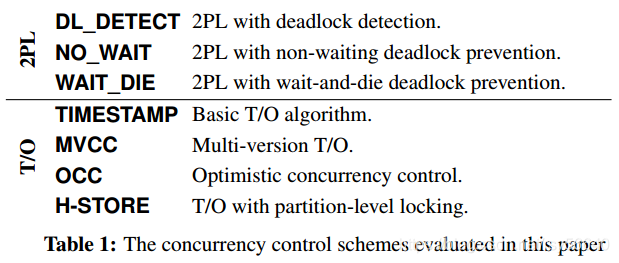Staring into the Abyss: An Evaluation of Concurrency Control with One Thousand Cores 论文阅读笔记
Concurrency Control Scheme
OLTP txns workload:
- short-lived
- small subset of data using index look-ups
- repetitive with different input

测试 Isolation level 是 serializable(因此一些 concurrency control 与通常有些差异)
2PL
- deadlock detection:检查 wait-for 图,并且选择合适的 txn abort
- non-waiting deadlock prevention:在 growing phase,如果拿锁失败(不等待),立即 abort
- wait-and-die deadlock prevention:允许较早的 txn 等待 之后的 txn 释放资源;如果较新的 txn 请求资源,abort 并在某些延迟后重启,序号不变。
Timestamp Ordering
分类标准:1. 检查冲突的粒度(tuple, partition);2. 检查冲突的时间(事务中还是结束时)
- TimeStamp:每次操作检查 ts,如果落后,就 abort;读操作 copy,为了 repeatable。(有些实现在一个 tuple 上有 read ts 和 write ts)
- MVCC:读操作不阻塞
- OCC:写操作在 private workspace;validation phase:read set 是否与其他 txns 的 write set 交集
- H-Store:
Design Choices and Optimization
造成 overhead 的几个方面
- lock thrashing
- ts allocation
- memory allocation / copy
2PL Optimization
- deadlock detection:把 wait-for graph 从多线程共享数据结构分解为比较独
2PL 最大的 bottleneck 是 lock thrashing

theta 从 0 到 0.8 表示对某一部分的 hotspot data 的访问频率增加。(就是 theta 越大,越针对某一个热点区域)

当 timeout 较小时,abort rate 较大,某种程度上减少了 lock thrashing
当 timeout 较大时,abort rate 较小,lock thrashing 严重,吞吐量低
要达到高吞吐量,既需要执行更多的 txns,还需要降低 lock thrashing
TimeStamp Ordering Optimization
TimeStamp allocation
- batching atomic addition
- CPU clock
- hardware counter

Figure 6 是只测试多线程获取 ts 的性能
atomic 下降的原因是 the cache coherence traffic from writing back and invalidating the last copy of the corresponding cache line for every timestamp.
batch 方法会遇到 contention

Figure 7 测试 real workloads
在 contention 下,batching atomic 方法是低效的,因为如果 abort,那么从这个 batch 中再挑一个 ts 还是落后于冲突 txn ts,这样一个 txn 会不断 abort 和 restart,直到一个 batch 的 ts 被耗尽。
这个问题其实可以解决,比如一个 batch=8,那么分配 x 代表可以获得以下8个:x, x+8, …, x+56。不过这样需要counter在每隔8个就要跳跃一下:x, x+1, …, x+7, x+64。伪代码如下:
static std::atomic_flag lock = ATOMIC_FLAG_INIT;
static uint32_t help_cnt = 0;
static uint32_t cnt = 0;uint32_t get_ts() {
while (lock.test_and_set(std::memory_order_acquire)) ;uint32_t ts = cnt;help_cnt++;help_cnt &= 0x7;cnt++;unsigned int overflow = (~help_cnt) >> 31;cnt += (overflow << 6) - (overflow << 3);lock.clear(std::memory_order_release);return ts;
}
实验分析
- scalability: 增加 core
- sensitivity: 改变某个测试参数(比如热点访问)
参数 theta
- 0: 所有 tuple 以相同频率访问
- 0.6: 10% 的热点数据被 40% 的 txns 访问
- 0.8: 10% 的热点数据被 60% 的 txns 访问
Read-Only Workload

- deadlock detection 和 No_Wait 都没有 contention,所以不会 abort,效率高。(话说 shared mutex 在多核下性能不知道怎么样,毕竟是系统调用)
- Wait_Die 和 MVCC 因为 ts allocation 导致性能下降
- OCC 和 TS 因为要 copy read set 保证 repeatable read,所以性能低
Write-Intensive Workload

- deadlock detection 要做大量的 wait-for graph 检测工作,持有锁时间较长,引发大量的 lock thrashing
- No_Wait 和 Wait_Die 在 growing phase 就判断是否 abort(实验中 abort 和 restart 开销较小)
- 与 TO,OCC 相比,MVCC 表现较好,因为不影响 read
- OCC 效果差因为即使会在 validation phase 检测出冲突,也会把整个 txn 做完

- No_Wait 大量时间用于 abort 和 restart,持有锁时间较短,所以性能好一点(实验中 abort 和 restart 开销较小)
- OCC 在多核下性能平稳,因为 validation phase 总能保证至少一个 txn commit

- 随着 data contention 增加,所有算法的性能都下降
Working Set Size

- 这幅图的斜率是 milion txn/s
- deadlock detection 和 No_Wait 的性能随着锁持有时间增长而下降
Read/Write Mixture

- TO 和 OCC 要 copy
- MVCC 在 write request 较少时性能较高,因为不阻塞读操作
关于多核性能的讨论

需要 software-hardware co-design
Reference
- CMU Advanced Database Systems - 02 Transaction Models & In-Memory Concurrency Control (Spring 2019) start from 1h 05min -> 1h 25min